South Africa’s Center for High Performance Computing (CHPC) hosted its seventh annual meeting, “Solving industry challenges through HPC and data adoption,” December 2-6, 2013 at the Cape Town Convention Center. CHPC Director Happy Sithole welcomed 350 HPC enthusiasts from universities, computational centers, and industry for a five-day event, including two full days of parallel technical workshops.
Why exascale in Africa?
South Africa was recently awarded the Square Kilometer Array (SKA) project: the most powerful telescope ever designed. The iconic endeavor will be installed in the extraordinarily “radio quiet” Karoo region of South Africa in the Northern Cape Province, and will include remote stations in SKA African partner countries such as Botswana, Namibia, Mozambique, Mauritius, Madagascar, Kenya and Ghana. The installation includes full dish and dense aperture arrays, associated data center, and enhanced network topology throughout the region. Its sister project, a low-frequency, sparse aperture array, will be built in Western Australia. The deployment timeline includes completion of the MeerKAT array in 2016 (the pathfinder project that’s already begun), and phase one construction of the SKA from 2018 to 2021, according to Jasper Horrell, SKA’s General Manager of Science Computing.
Since electromagnetic waves from distant galaxies take a tremendous amount of time to travel through space, we’ve only seen them as they originally were, not as they currently are. SKA will allow us to explore the universe as it was before the first stars and galaxies formed. Telescopes, like the Hubble, take pictures of the universe in the visible part of the electromagnetic spectrum. SKA looks at the radio part of the spectrum. A radio telescope array can be used in a number of different modes. In one mode, pictures of the “radio sky” are formed. In another, high-precision timing measurements are made in order to study pulsars, an exotic type of star, for example. “SKA’s application will push the HPC industry’s envelope in terms of fast computing, very fast data transport, networked sensors, and imaging algorithms,” said Horrell.
Cambridge HPC Center Director Paul Calleja echoed Horrell’s remarks by saying “SKA is currently the world’s most ambitious information technology project and the first real exascale-ready application. As for big data, it’s a problem looking for a solution.” In addition to SKA’s technical challenges, there are physical barriers associated with hosting cutting-edge radio technology and data centers in regions where temperatures tend to soar. Yet, remote locations are perfect for SKA’s objectives, which include finding the answers to five fundamental questions about our universe, including the question that intrigues everyone: “Are we alone?”
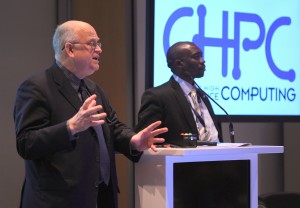
Thomas Sterling, Chief Scientist, Center for Extreme Scale Technologies (CREST), Indiana University-U.S.
According to Thomas Sterling (Chief Scientist, Center for Extreme Scale Technologies (CREST), Indiana University-U.S.), “The systems needed to support SKA haven’t been invented yet.” When asked how they might differ, Sterling said “Next-generation HPC systems will be simpler by design, more energy efficient, and able to handle more complex functions.”
Horrell explained how SKA will influence the world’s high-tech workforce. With an operational timeline of 30-50 years, and billions in terms of capital investment, Africa’s education system has already begun to support a range of new competencies. Additional skills will be fostered for SKA’s design, construction, and long-term operation. CHPC will train many who are supported by the project, and SKA is already hiring. Those who are trained in South Africa and partnering countries will circulate to support leadership-class systems everywhere. With more Africans entering the global high-tech pipeline, the (mostly white male) STEM education and HPC support community will greatly benefit from added diversity. “Although Astronomy is driving the initiative in Africa, SKA’s slipstream will support cross-cutting multidisciplinary research for the world’s public and private sectors alike,” said Horrell.
Build it, and they will come.
An HPC Workshop sponsored by the South African Department of Science and Technology (DST), and coordinated by the Southern African Development Community (SADC) and CHPC, focused on the development of a collaborative cyberinfrastructure for SADC’s member-states, which will encompass Sub-Saharan Africa, or the lower half of the continent. Representatives from DST, Africa Multilateral Corporation sub-program, and the SADC secretariat underscored the importance of developing Africa’s human capital through HPC education and outreach. On Wednesday, Dec. 4, United Kingdom Counsel General Chris Trot officially declared the UK’s support of technology to enable greater research, education, and industrial outcomes in Southern Africa.
“At their 2007 summit, the African Union (AU) heads of state called on all member-nations to allocate one percent of their gross domestic product (GDP) for research and development. The build-out of this CI will rely on each country’s support,” said SADC Senior Science and Technology Adviser Anneline Morgan. “Africa’s socioeconomic development, entrepreneurship, technology transfer, and research will be advanced through this multinational collaborative investment,” she added.
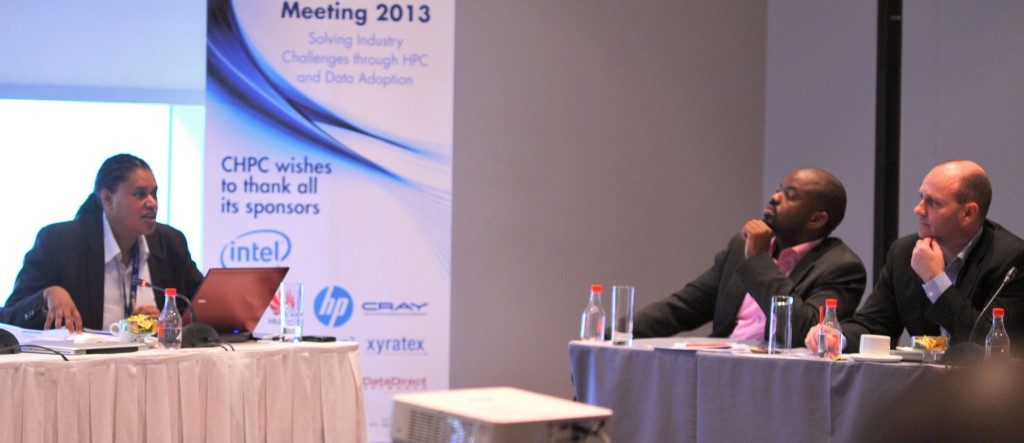
“Africa’s socioeconomic development, entrepreneurship, technology transfer, and research will be advanced,” said Anneline Morgan, SADC Senior Science and Technology Adviser.
Additional workshop activity included a presentation by Thom Dunning and Danny Powell from the U.S. National Center for Supercomputing Applications. Clement Onime from the International Center for Theoretical Physics (ICTP), delivered a keynote talk on behalf of Joseph Insiful (Institute of Mathematical Sciences, Ghana) entitled ‘HPC initiatives in Ghana and other African Countries.’ Dr. Sithole talked about CHPC’s seven-year history, its current systems, and the research community it supports. He explained how the University of Texas at Austin-U.S. donated Ranger, a system recently retired by the Texas Advanced Computing Center (TACC). Twenty Ranger racks were divided among data centers in Botswana, Tanzania, and South Africa and will serve as points of presence for the new cyberinfrastructure.
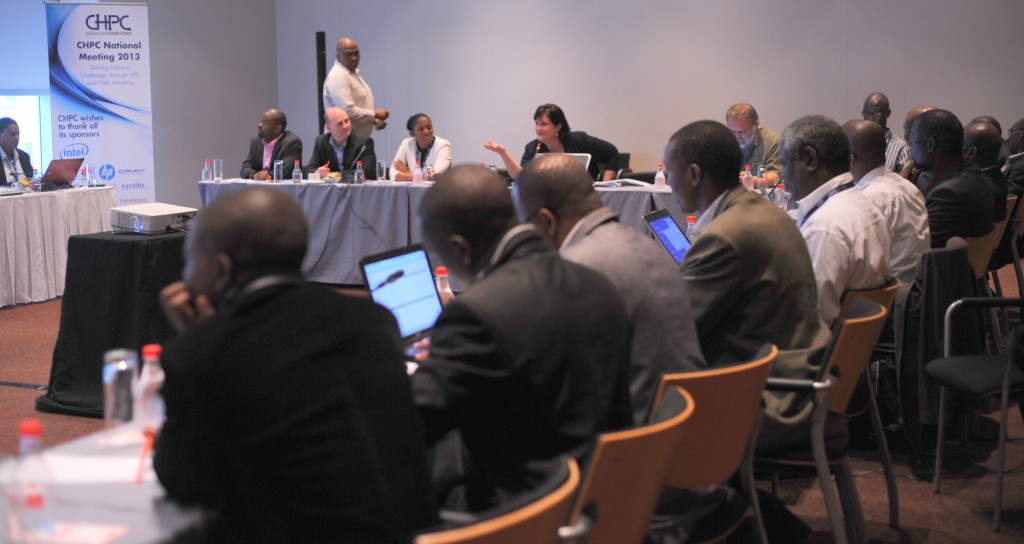
As correspondent, STEM-Trek’s Elizabeth Leake (center) also offered external relations assistance. She’s delighted that Southern Africa’s initiative will enhance the global STEM pipeline.
SADC delegates delivered presentations about activities in their countries focusing on their existing technology resources, what they could share in a collaborative ecosystem, what’s needed for the future, and national research priorities. While infrastructure and workforce development are of critical importance to all, priorities differ depending on geography, regional climate, and resident industries. Some hope to shift their GDP’s from petroleum-based exports, to agriculture or ecotourism in the coming years. Yet, all recognize that priorities can shift and keep a watchful eye on climate change as new regions experience drought, unprecedented weather patterns, and related public health concerns.
Agricultural research was a top priority for three testifying SADC countries, and would be for others who weren’t present. Greater understanding of Africa’s unique crop and animal species will enhance the global food supply, and every agricultural nation’s GDP. TACC’s Dan Stanzione shared Ranger research highlights, and explained the iPlant Collaborative project’s user-friendly interface and collection of resources developed by and for the plant science research community.
 Mother Africa: fertile ground for innovation and tech transfer
Mother Africa: fertile ground for innovation and tech transfer
Approximately two-thirds of the world’s research is supported by government funds. Naturally, research that supports federal interests is favored. Researchers with access to advanced computational resources and support are therefore more capable of transformative discovery in arenas that align with their nation’s priorities.
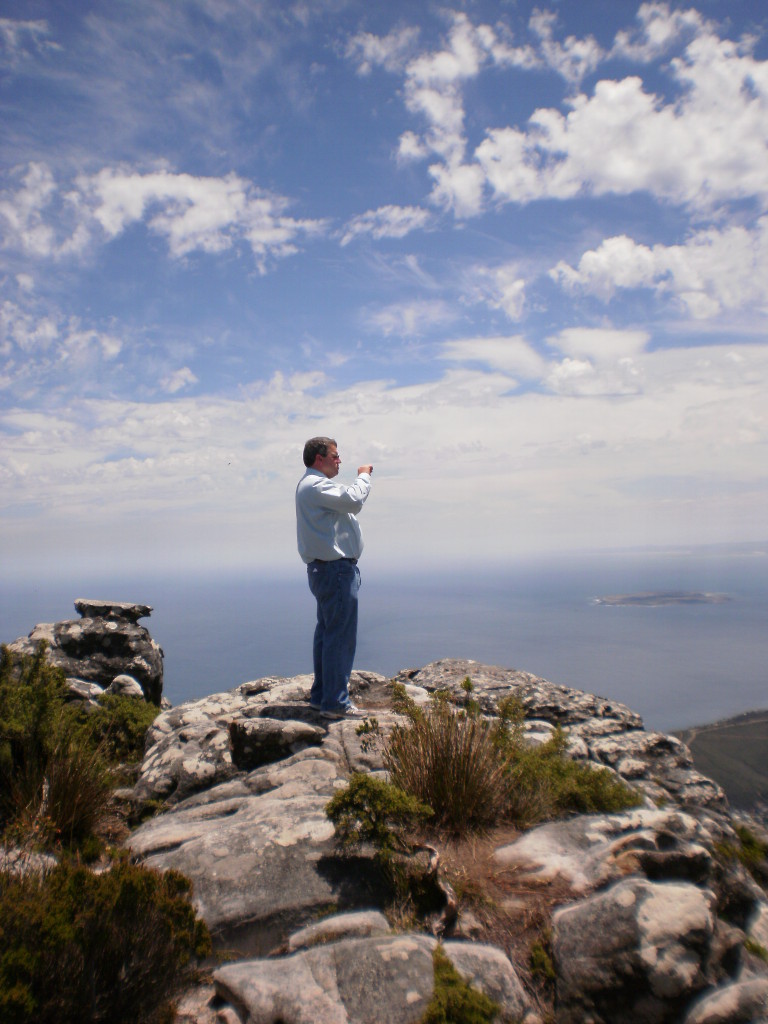
Dan Stanzione (Texas Advanced Computing Center-U.S.) takes a moment to experience one of Africa’s epic views from Table Mountain.
African countries with an abundance of fossil fuels, precious metals, and gemstones will most likely contribute to the world’s understanding of geology, geochemistry, engineering, and materials science. All hope to improve public health and prevent disease, but some African nations suffer more than others from HIV-AIDS, Tuberculosis, Malaria, and Yellow Fever. Those who live in affected regions would be most passionate about finding cures. Generations of Africans have believed indigenous plants possess medicinal qualities. Their theories could be scientifically proven, and life-saving pharmaceuticals could be patented by African scientists who would make them available to global markets. Scholars who grew up in the shadow of Africa’s mining operations may have developed a keen interest in environmental science. Her vast desert regions have a profound impact on the world’s climate, but global projects rooted elsewhere have neglected to study them sufficiently. With more than 2,000 languages spoken on the continent (521 in Nigeria alone), Africa is fertile ground for research in ethnology, anthropology, sociology, and linguistics. Economically, there’s an emerging middle class in urban regions that offers a rich test bed for research relating to business development, product placement, and marketing. Island nations, like Seychelles, are concerned with how atmospheric change impacts fishing and ecotourism industries. SKA and CHPC have industrial partners that will promote business-savvy scientists who are especially concerned with technology transfer, supply chain management, and global commerce.
Through the intelligent use of cyberinfrastructure, SADC’s combined wealth will be greater than the sum of its parts. Each nation represents unique geography, intellectual communities, infrastructure, and industrial assets that offer synergy when combined. For example, Angola announced 2014 plans to deploy a telecommunications satellite called “Angosat” to improve telecom service in its remote regions. In the future, with a management framework in place, both cost and benefit of significant national investments, like Angosat, could be shared with sister-nation residents and others who traverse national borders in the interest of commerce, research, and government relations.
Paying it forward in Africa
In addition to the University of Texas-U.S. sharing Ranger, European and Chinese HPC centers have pledged their support of CHPC’s effort by offering two additional repurposed systems. This global investment gives novice users hands-on experience with a variety of system architectures. Each installation and supportive local infrastructure will create a point of presence from which to expand regionally, nationally, and throughout SADC’s 15 member states. SADC and CHPC seek guidance and partnerships from experienced HPC centers and were pleased to know that the U.S. National Science Foundation’s XSEDE project leader, John Towns, pledged to help. “It’s in the world’s best interest for those of us with experience in the development and management of CI/eInfrastructure programs to lend South Africa and the SADC region a hand as they begin to build a collaborative HPC ecosystem for Southern Africa,” he said.
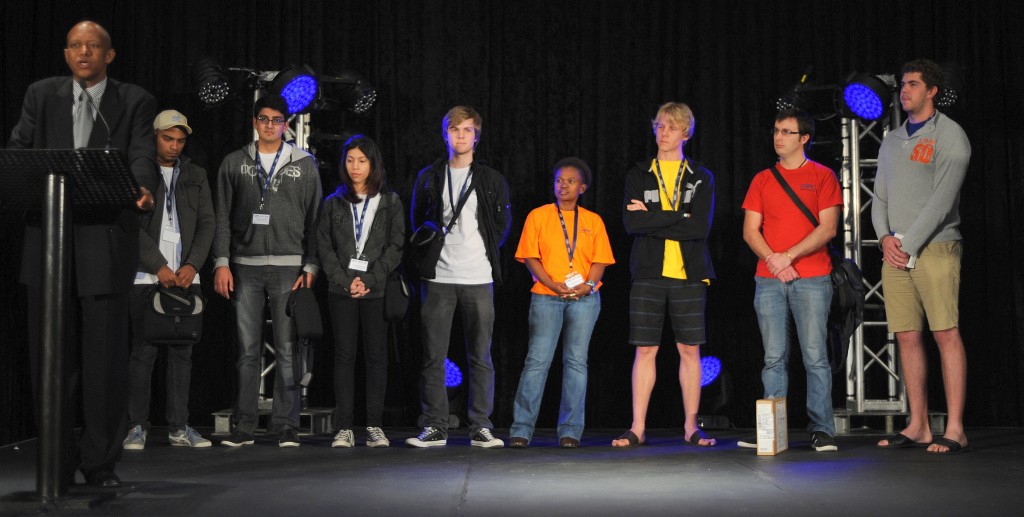
2013 student cluster competition winners and alternates who will travel to Leipzig, Germany next summer for the International Student Cluster Challenge.
Student Cluster Challenge
The 2012 CHPC conference hosted South Africa’s first Student Cluster Competition. Sponsored by Dell, each team was afforded a 250,000R (1,812EUR, or 2,500USD) budget, allowed to choose from a menu of hardware options, and given five days in which to build a unique cluster design. Last year’s SA team progressed to win the International Supercomputing Conference Student Cluster Challenge in Leipzig, Germany. Once again, student teams from around South Africa vied for the 2013 title. “We hope the winning team will continue the tradition in June by flying South Africa’s flag at ISC’14,” said Dr. Sithole.
June 27, 2014 update: They won! See HPCWire story about their victory.
 Mark your calendar for HPC in the African Bush in 2014!
Mark your calendar for HPC in the African Bush in 2014!
The 2014 CHPC annual meeting will be held December 1-5, 2014 at the Kruger National Park in Mpumalanga, South Africa. The theme is “Towards an Energy-efficient HPC System,” and registration opens May 1.
To preview the many natural wonders South Africa has to offer, visit Jen Reviews: 100 Best Things to do in South Africa.


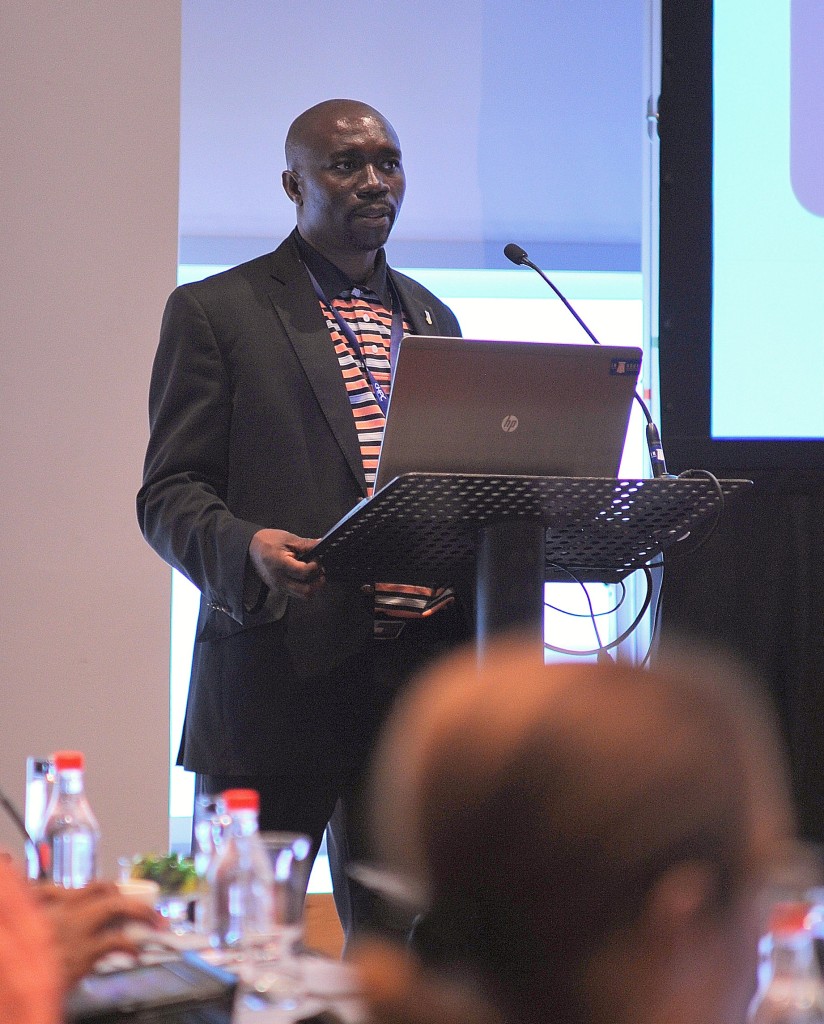
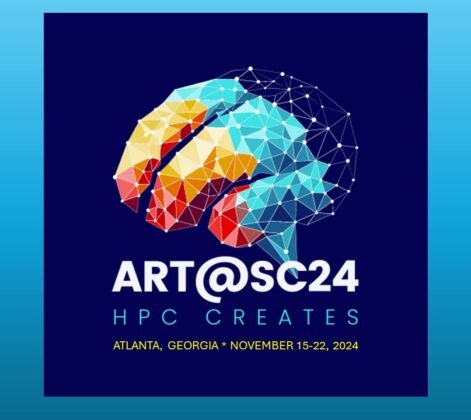


Thankfulness to my father who stated to me on the topic of
this web site, this web site is in fact amazing.